THE FUTURE OF PD: A COLLECTION OF BEST PRACTICES
One thing is clear: “sit and get” has got up and gone. “How can we lecture teachers for 50 minutes about providing hands on, engaging instruction to students?” asks Jeff McCoy from Greenville County (SC) Schools. Today’s PD has to prepare teachers for “a new way of teaching and learning,” says Donia Doudican of Sapulpa (OK) Public Schools. From various online options to teacher-leader models and more, districts are taking new methods and ideas on board. And teachers at Gurnee School District 56 are literally getting “on board” with their “Tech Trek” gamified PD.
The future, it seems, is already here. “Badges, or micro-credentials, will become powerful tools to motivate educators,” says Steve Wick from Neuqua Valley (IL) High School. Robert Voges from Volusia County (FL) Schools, who is asking some key questions about technology and generational differences, agrees. Twenty-first-century teachers need PD that’s personalized, flexible, and embedded in classroom practice. In the stories below these educators share ideas, successes, and challenges.
GAMIFIED PD: SIMPLE, USER-FRIENDLY, AND FUN
Gurnee School District 56 (D56), a Pre-K–8 district with 2,200 students 45 minutes north of Chicago, is a 1:1 iPad district and Apple Distinguished Program. The district’s PD has evolved from “sit and get” to an Apple PD trainer of trainers model. This organic and self-replicating program was so successful that “we found we didn’t need how-to’s anymore,” says Colleen Pacatte, assistant superintendent for curriculum and assessments. They moved to a focus on SAMR, and programs like their Summer Tech Academy and open office hours before school starts help ensure that teachers have the training and support they need.
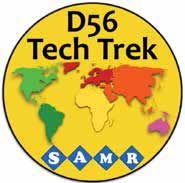
TECH TREK
D56 Tech Trek game board But what makes PD at D56 unique—and fun—is “Tech Trek,” a popular gamified PD option developed entirely by teachers. Pacatte researched gamification and badging, assembled a diverse team and gave them some parameters (e.g., it would be SAMR-based, and the evidence submitted had to be student work), and set them loose. While the journey took these teachers-turned-game-developers out of their comfort zones, Pacatte was impressed by their collaboration, problem-solving, hard work, and creativity. She emphasizes that handing teachers a ready-made solution robs them of the learning process and ownership.
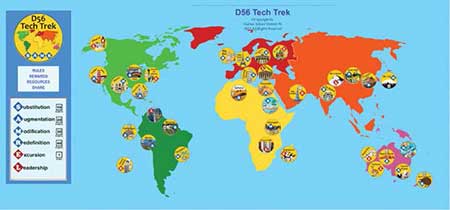
Romie Bloom, one of the team members, agrees. It’s important, she says, that it’s “easy to play, including rewards—if it requires too many steps or it’s too difficult to succeed, people will not participate.” Playing Tech Trek is entirely optional.
Tools and ideas to transform education. Sign up below.
Teachers accrue points for each badge, linked to SAMR levels, on six continents on the virtual game board (there are also “L” badges for leadership integrating tech in the classroom and “E” badges for “excursions,” or stepping off the game for an activity such as reading an article or listening to a TED talk). Clicking on a bright yellow icon brings players to a Weebly Web site where they’re given a choice of two challenges (or they can create their own) to earn the badge.
Teachers can shop with their points at “SAMR-Mart” for things like a free jeans day, coffee, or 20 minutes of classroom cover—or they can save them up to earn a full comp day. A year and a half in, Pacatte suspects most teachers are choosing the latter option. “Still,” she says, “we’re already seeing a bump in academics and greater levels of tech integration, and even gamification, in classrooms, and the price of a substitute for a day is less than a conference.”
Teacher Stephanie Coe says that Tech Trek “provides a framework that encourages me to experiment with integrating technology at all levels of the SAMR model.” The game has also given her new ideas and helped her to be more reflective of her practices.
THE REAL PAY-OFF
Teachers submit evidence of student work via Google Forms, and the folders containing this work are a rich, curated source of ideas for everyone. Each submission needs to be approved by a colleague and the principal, and this is where Pacatte finds the real pay-off. “Teachers and administrators are talking to each other, having these great conversations about if, say, this is modification and why,” she says.
Pacatte estimates that about 60 per cent of teachers are playing at some level. Tech Trek’s launch featured a simulated flight, complete with pre-flight movie and bags of peanuts. “It’s a fun, stress-free, optional tool,” Pacatte says. “This kind of PD is part of, and honoring, what teachers do every day. It’s embedded in the classroom, and that’s the best kind of PD.”
For more information on D56 Tech Trek, go to https://youtu.be/xm-G_4K8Ggk.
TOOLS THEY USE
GURNEE SCHOOL DISTRICT 56
► Epson Short-Throw Projectors
► FrontRow Sound Field Systems
► iPad airs
► MacBook Pros
► Polyvision Eno Boards
FINDING NEW MODELS FOR A NEW WAY OF TEACHING
Left: LMS training at Sapulpa Public Schools; Right: Sapulpa High School teachers engage in ELA Content Training and collaborative lesson planning When it comes to providing traditional PD opportunities, Sapulpa (OK) Public Schools (SPS) has, according to digital curriculum project manager Donia Doudican, “pretty much tried it all.” They’ve contracted national gurus, shared keynote speakers with surrounding districts, had staff present sessions, travelled to conferences, and done online training.
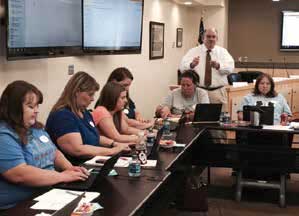
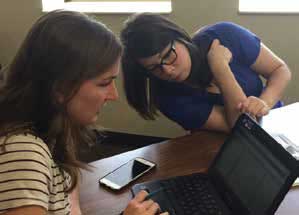
But implementing a 1:1 program (with Chromebooks) brought new opportunities and changes for the district. Doudican says that they see “now, more than ever, a need to focus on a different kind of professional learning, one that will help our teachers with the pedagogical shift.” PD that is job embedded and practice based is critical, since they’re rolling out not just the devices but “a new way of teaching and learning.” In addition, Oklahoma teachers will have an individual PD plan tied to their state evaluation beginning in the 2017–18 school year, so SPS wants to ensure teachers have all the support they need.
A PERSONALIZED APPROACH
Although SPS staff are, overall, positive about the differentiated approach to learning technology, even careful, phased change brings challenges. Doudican says that offering “a wide variety of learning opportunities” in different learning styles is key—but to do that they needed to find a better way to differentiate their training process. They’ve been able to do this effectively through working with a Houghton Mifflin Harcourt Dedicated Consultant.
“We have someone from HMH in our district every day,” Doudican says, “helping bring very real, practice-based PD that takes into account our district’s culture as well as the specific needs of our students.” This year they’re planning to focus on the coaching method for PD, continuing to emphasize a personalized approach.
MINIMIZING CONFUSION WITH CHUNKING
“The best advice and biggest ‘aha’ in regards to PD thus far,” Doudican says, “has been the idea that we need to ‘chunk’ the information being taught. There is just so much to learn.” Focusing on one or two specific things within the LMS or digital curriculum at a time has eliminated some of the confusion and information overload so teachers can integrate and master the material and feel confident to keep moving forward.
TOOLS THEY USE
SAPULPA (OK) PUBLIC SCHOOLS
► BrainHoney/BUZZ
► Chromebooks (grades 3–12)
► Desktops and/or touchscreen devices (Pre-K–2)
► edFusion
► GAFE
► HMH digital curriculum
► SMART Boards
TEACHING STRATEGIES, NOT TOOLS
Teachers at GCS engage in a PD session led by Discovery. Greenville County Schools (GCS), the largest district in South Carolina, is an old hand in the cutting-edge world of edtech. The 87-school district uses a wide variety of edtech tools, apps, and devices, has committed to a three-year refresh program, and has partnered with Discovery Education for 14 years. But interim associate superintendent Jeff McCoy emphasizes that the tools are there to enhance instruction.
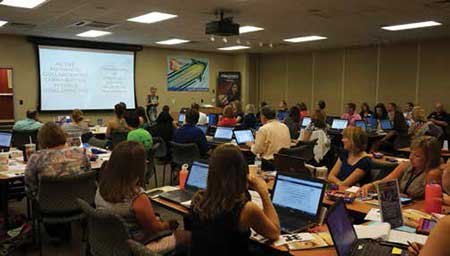
McCoy credits the GCS instructional technology staff with doing a good job training teachers to implement technology in their classrooms in the past but, he says, “typically the teachers who attended were the eager ones who loved technology.” Follow-up was also difficult in such a large district.
TEACHER-LEADERS
Teachers at GCS enjoy an active and interactive PD session. As GCS has moved increasingly towards offering “hands-on, engaging, and just in time” PD, implementing Discovery Education’s Digital Leader Corps model (DLC) was a natural step. DLC, a comprehensive PD program including pedagogy, tools, coaching, and feedback, develops teacher-leaders to serve as change agents in the district’s transition to dynamic digital learner-centered environments. McCoy describes DLC as “a perfect marriage” for GCS.
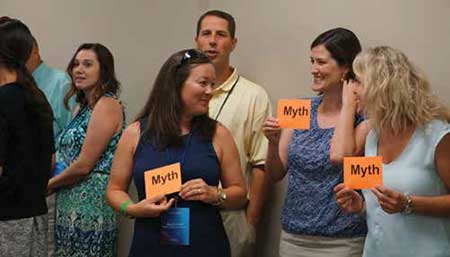
McCoy has been encouraged by teacher feedback, which has focused not so much on the technology but on the instructional strategies learned. In surveys, teachers also emphasized how encouraging and empowering they find collaboration, sharing ideas, and building relationships with colleagues. Like their students, they also enjoy being able to get up and move around while learning.
The perfect candidate for a teacher-leader, McCoy says, “is strong in instructional practice and willing to learn technology.” Although the district doesn’t ask teachers to open up their classrooms as learning labs for other teachers to learn and observe until year two, McCoy says many are eager to start sharing what they’ve learned immediately.
TAKE THE TIME TO LEAD BY EXAMPLE
McCoy notes that irony that “We preach to teachers about providing hands on, engaging instruction to students—and we do it by lecturing to them for 50 minutes!” Since many people are visual learners, this kind of modeling helps teachers visualize how they might use these best practice strategies in their classrooms.
With so many new options for PD formats, McCoy advises districts to plan their PD first and then “choose the format that best fits (asynchronous virtual, live via distance learning, or face to face).” The biggest challenge with providing this type of PD, McCoy says, is time. It’s “extremely time intensive and a huge culture change. However, the investment you make upfront will pay off tremendously in the end.”
TOOLS THEY USE
GREENVILLE COUNTY SCHOOLS
► Chromebooks
► Discovery Education Techbooks
► Gizmos
► GAFE
► OverDrive
► Promethean Boards
NEXT-GENERATION PD NOW
Personalizing PD is challenging. But personalizing PD at Volusia County (FL) Schools, where thousands of teachers at over 80 different sites using a wide variety of technology tools teach 61,000 students in a demographically diverse district stretching west and south of Daytona Beach, presents a colossal challenge.
As the district implements instructional shifts to meet their “big three” goals—achieving standards, establishing a culture for learning, and personalizing learning—they’re drawing a big edtech breath and asking what pieces talk to each other, how, and why. Robert Voges, professional learning specialist for the district, explains that the SAMR model is helping them to ask the big questions, and sometimes the hard questions, about technology, including “How can we use what we’ve already got more effectively?”
ONE-SIZE-FITS-ALL IS GONE
As a PD facilitator, Voges finds the flexibility, breadth of options, and à la carte convenience of the Truenorthlogic PD Premium Library invaluable. With TNL, teachers have a vast array of options. They can focus on the content they need to better equip them to teach their students in their context, they can learn when and where it’s most convenient for them, and the district pays only for the units used.
The core question when it comes to PD, Voges says, is not whether someone has attended a workshop, or even received a credit, but whether the teacher can put that skill into practice in the classroom. “It’s about competence,” he says. “What can you do?”
TODAY IS YESTERDAY
“As quickly as we’re wrapping our heads around online modules,” Voges says, “they’re becoming a thing of the past.” Millennial teachers are sharing best practices in twitter chats at 5:30 a.m. and trying them out at school a few hours later. Voges sees the future of PD in micro-credentialing—learning and presenting evidence of mastery of smaller chunks of material. He sees a future where teachers present badges in addition to, or even instead of, transcripts.
Voges is a Baby Boomer who enjoys attending conferences, but he says this mind shift is critical and parallels the kind of proficiency we’re asking students to demonstrate. “We need to understand the millennial difference and give them the tools and scaffolding they need to learn. If we think this is challenging, wait until the Always-On generation gets here.”
TOOLS THEY USE
VOLUSIA COUNTY SCHOOLS
► Dell laptops
► Edmodo
► iPads
► Office 365
► Truenorthlogic PD Premium Library
EMPOWERING THE TEACHER: HORSE BEFORE THE CART PD
THE WHY
Neuqua teachers sharing edtech success stories Steve Wick, technology coordinator at Neuqua Valley High School, part of Indian Prairie School District 204 (ISPD) in suburban Chicago, says their current approach to PD starts with “good teaching pedagogy connected to student skills and the four Cs (collaboration, communication, critical thinking, and creativity).” A BYOT and GAFE district, ISPD 204 plans to be 1:1 with Chromebooks in the 2017–18 school year.
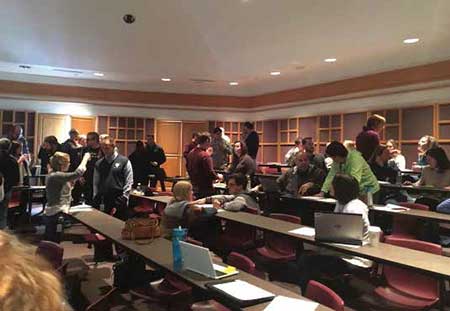
As they’ve moved from traditional methods of delivering PD to a personalized approach featuring activities that model student-centered learning whenever possible, Neuqua has relied on some key resources including a collaborative blog for tech tips, interactive HyperDocs for GAFE training, and resource Web sites for just-in-time learning, in addition to face-to-face collaboration.
Focusing on the why before the how, Wick says, has helped teachers learn to use technology to enhance instruction and has empowered them to own their learning. A shift to GAFE as a foundation for most activities connected to edtech has also been fundamental.
THE HOW
Neuqua teacher showing her GAFE love Wick encourages districts considering shifts in their approach to PD to “build teacher collaboration into everything you do” and to “build resources to support learner-centered professional development and encourage the development of Personal Learning Networks.” He also advocates utilizing instructional coaches who can work in classrooms to support instruction enhanced by technology.
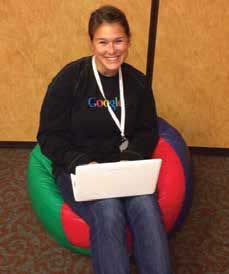
A number of innovative thinkers and resources have influenced the Neuqua vision for teaching and learning, including Why School? by Will Richardson, The Innovator’s Mindset by George Couros, P21 Partnership, and TED Talks Education. While Wick reiterates that change is slow and patience is a virtue, as a result of implementing this why-focused, collaborative, and learner-centered PD at Neuqua Valley, they’re seeing “more student-centered activities in our classrooms with an emphasis on the 4 Cs.”
TOOLS THEY USE
NEUQUA VALLEY HIGH SCHOOL
► Collaboration: GAFE, Padlet, Google Keep
► Creativity: WeVideo, Google Drawings, Canva, Piktochart
► Communication: Google Classroom, Remind, Blogger
► Critical Thinking: Newsela, TED-Ed, Coggle
FREE CONFERENCE
In partnership with Discovery Education, GCS offers an annual Upstate Technology Conference. This popular conference is free to all registered participants. For more information go to https://www.greenville.k12.sc.us/gcssi/.
